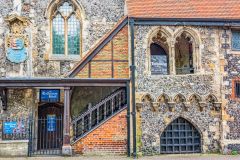
Much of the medieval town walls still stand, and there are numerous medieval and Tudor buildings in the town, including the Fisherman's Hospital, an almshouse dating to 1600.
Much older is the Tolhouse, founded about 1300 and said to be the oldest civic building in England. It retains its original dungeons, so wrong-doers beware!
Many of the old lanes and twisting alleys of medieval Yarmouth remain in the area called The Rows, near South Quay. A much more recent building is the imposing town hall, built from 1880-1882 and standing on Hall Quay, facing the River Yare.
Elizabethan House Museum
On South Quay stands a beautifully preserved 16th-century house, now preserved as a museum, tracing the lives of people who lived here from Elizabethan to Victorian times. One of the most intriguing features is 'The Conspiracy Room', where Parliamentary supporters planned the execution of Charles I.
Greyfriars and the Row Houses
On The rows are two of Great Yarmouth's most historic sites; the ruins of a 13th-century Franciscan friary and The Row Houses, a pair of 17h century merchant's houses later converted into tenements. One house is preserved as it was in 1870, and boats a very finely crafted Jacobean plaster ceiling. The other Row House shows what life was like in 1942, immediately before the house was hit by a German bomb.
Close to the Row Houses stand the crumbling ruins of Greyfriars, a Franciscan friary established in the 13th century. The friary was dissolved by Henry VIII and over time the monastic buildings were gradually absorbed into the surrounding buildings.
During WWII an incendiary bomb exposed medieval features long hidden by surrounding buildings. There are a pair of stone-vaulted cloisters, two tomb recesses and the remains of 14th-century wall paintings.
Caister Castle and Roman Fort
Three miles outside Great Yarmouth is Caister Castle, a 15th-century moated fortress built by Sir John Fastolf, the model for Shakespeare's Falstaff. The castle is one of the earliest medieval buildings in England to make extensive use of brick as a building material.
Nearby are the remains of a Roman Saxon Shore fort, built around AD 200. The fort was occupied until well into the 4th century, then abandoned, only to be reoccupied in the 7th century as a Saxon settlement.






 We've 'tagged' this attraction information to help you find related historic attractions and learn more about major time periods mentioned.
We've 'tagged' this attraction information to help you find related historic attractions and learn more about major time periods mentioned.


